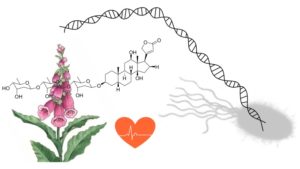Synthetic Biology of Plant Natural Products
- Gene discovery in medicinal plants
A current focus is to elucidate the complete biosynthetic pathway of cardenolides. Cardenolides extracted from Digitalis plants have been used for the treatment of heart failure and atrial fibrillation since the 18th century. Digoxin, a compound in the cardenolide family, is on the World Health Organization’s List of Essential Medicines. The current method for digoxin production relies exclusively on plant extraction, leading to an unavoidable mixture of derivatives that complicates application. However, the genetic components of cardenolide biosynthetic pathway is largely unknown, hindering the efforts to microbially producing this class of compounds. As such, we are applying a comprehensive approach that combines differential transcriptomic analysis with comparative high-resolution metabolomics to survey transcriptomic patterns for the identification of the unknown genes involved in cardenolide biosynthesis.
- Microbial engineering for producing plant-derived drugs

Genetically manipulatable microbes such as Escherichia coli and Saccharomyces cerevisiae are excellent hosts for efficient production of plant natural products because of their fast growth rate and potential for high productivity of chemicals. This production strategy has no requirement for climate, soil, pesticides, fertilizers or geographic locations, compared with the farming method to produce plant-based medicines. We are currently focusing on producing terpene-derived drugs in both E. coli and S. cerevisiae by first establishing universal terpenoid-producing microbial platforms using synthetic biology and metabolic engineering. Genes responsible for complex terpenoid production, such as cardenolides in Aim 1, will be introduced into the platform strains to achieve high productivity of plant natural products.
- Cellular trafficking of plant natural product biosynthetic pathways
 Plants synthesize natural products through pathways spanning multiple organelles such as chloroplast, mitochondrion, vacuole, and endoplasmic reticulum. Such complex organization implies extensive intracellular transport of pathway intermediates, but little is known regarding the enzymes and the mechanisms involved in the subcellular trafficking of plant natural products. Membrane contact sites between chloroplast and endoplasmic reticulum (PLAMs: PLastid Associated Membranes) have been proposed to be the route for transferring hydrophobic intermediates for terpenoids and membrane lipid biosynthesis. We are studying the function of PLAMs through genetic screening and biochemical assays using the model plant Arabidopsis thaliana to identify proteins essential for maintaining the ER-chloroplast contact sites. The findings from this research will reveal the universal mechanism of metabolite trafficking at a subcellular level.
Plants synthesize natural products through pathways spanning multiple organelles such as chloroplast, mitochondrion, vacuole, and endoplasmic reticulum. Such complex organization implies extensive intracellular transport of pathway intermediates, but little is known regarding the enzymes and the mechanisms involved in the subcellular trafficking of plant natural products. Membrane contact sites between chloroplast and endoplasmic reticulum (PLAMs: PLastid Associated Membranes) have been proposed to be the route for transferring hydrophobic intermediates for terpenoids and membrane lipid biosynthesis. We are studying the function of PLAMs through genetic screening and biochemical assays using the model plant Arabidopsis thaliana to identify proteins essential for maintaining the ER-chloroplast contact sites. The findings from this research will reveal the universal mechanism of metabolite trafficking at a subcellular level.